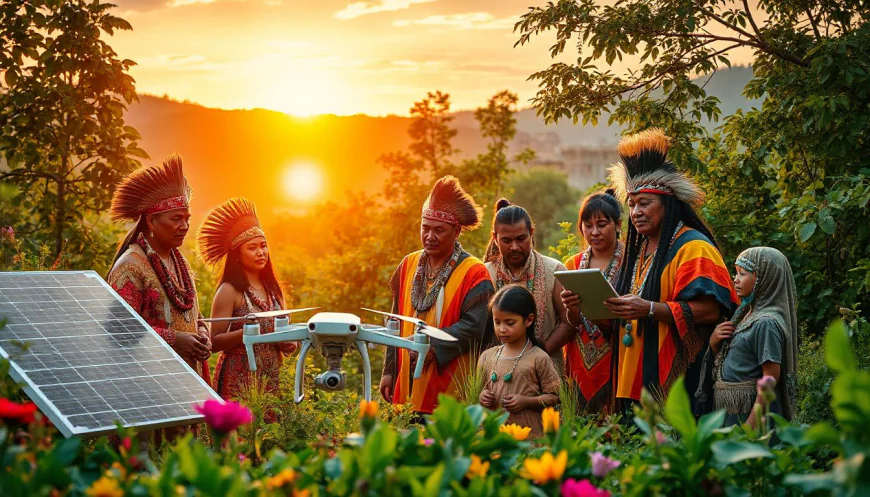Indigenous Innovation: How Traditional Knowledge Meets Modern Tech
Across the world, more people are starting to see the value in indigenous ways of knowing. These ancient practices hold a wealth of ideas that can help solve today’s biggest problems. When traditional knowledge blends with modern technology, it opens new doors for sustainable growth and healthier ecosystems. This mix isn’t just about curious experiments; it’s about building a better future while respecting cultures and nature. While there are many benefits, challenges like protecting this knowledge and ensuring fair use also exist. Let’s explore how this powerful connection is changing the way we think about innovation.

The Significance of Indigenous Knowledge Systems
Understanding Indigenous Knowledge
Indigenous knowledge includes the wisdom, skills, and practices that communities have developed over thousands of years. It influences everything from farming to medicine, and from wildlife management to cultural rituals. The key point is that it’s based on direct experience with the environment, making it deeply practical. These traditional systems show incredible adaptability, evolving with changing conditions across generations.
Global Recognition and Value
Many international groups now see indigenous innovation as vital. UNESCO, for example, has programs aimed at protecting indigenous wisdom. Statistics reveal that indigenous lands are often richer in biodiversity—they manage 80% of the world’s remaining untouched ecosystems. Their ways of farming and conserving nature set examples for sustainable living that global communities are starting to follow.
Challenges Facing Indigenous Knowledge Preservation
Despite its importance, traditional knowledge is under threat. Modernization, climate change, and rapid globalization push indigenous cultures aside. Young generations may lose touch with ancestral practices. To combat this, many organizations are creating digital archives and legal protections to record and preserve these traditions for future generations.
Bridging Traditional Wisdom and Modern Technology
Digital Documentation and Preservation
Efforts like Indigenous Digital Archives are digitizing old stories, songs, and farming techniques. Doing this helps keep knowledge alive even if elders pass away. It allows researchers and communities to access and share this wisdom easily. This preservation also fuels new research that can benefit everyone.
Co-Creation of Innovation
Many projects now involve indigenous communities working with tech developers. For example, scientists collaborate with elders to discover plant medicines or develop apps based on traditional practices. In Latin America, indigenous groups use mobile tech to monitor wildlife or track water quality. Such collaborations show how combining old and new ideas can produce practical tools and solutions.
Ethical Considerations and Intellectual Property
Respecting indigenous rights is crucial. We must avoid taking their knowledge without permission, a practice called biopiracy. Instead, benefits should be shared fairly, ensuring communities are partners in innovation. Clear guidelines and community-led research help make this happen.
Successful Examples of Indigenous Innovation Using Modern Tech
Agriculture and Sustainable Farming
In Australia and Latin America, indigenous methods are now combined with precision farming technology. This approach boosts crop yields while protecting soil and water. It’s like planting seeds for both crops and ecosystems, creating a win-win for farmers and nature.
Medicine and Healthcare
Indigenous groups in the Amazon hold detailed knowledge of medicinal plants. Scientists now work with locals to test and develop new drugs from these plants. This partnership turns ancient wisdom into new medicines, potentially helping millions with fewer side effects.
Conservation and Environmental Management
Indigenous rangers use GPS, drones, and remote sensors to keep watch over protected areas. They catch illegal logging and poaching early, saving animals and plants. Their efforts show how traditional knowledge combined with modern tools makes environmental protection stronger.
Renewable Energy and Climate Adaptation
Many native communities are adopting solar panels and wind turbines. In Arctic regions and island nations, these solutions help them adapt to climate change. Using their own planning skills and modern tech, they enjoy cleaner energy and greater resilience.
Challenges and Opportunities for Future Innovation
Barriers to Integration
Despite the promise, many obstacles remain. Cultural sensitivities and mistrust can slow down collaborations. Limited access to technology and training prevents some communities from fully participating. Building trust and offering education are keys to smarter integration.
Policy and Legal Frameworks
Strong laws and treaties protect indigenous rights. Governments and organizations should create policies that promote fair use of traditional knowledge. International agreements, like the United Nations Declaration on the Rights of Indigenous Peoples, offer a good foundation for this.
Promoting Indigenous-Led Innovation Ecosystems
Supporting local entrepreneurship helps communities lead their own progress. Funding, mentorship, and partnerships can spark new ideas rooted in tradition. Creating innovation hubs within indigenous territories empowers people to develop solutions for their unique needs.
Conclusion
Bringing together indigenous knowledge and modern technology isn’t just smart—it’s essential. This blend offers solutions that respect the planet’s health and cultural diversity. By working with indigenous communities on equal footing, we open the door to innovations that benefit everyone.
Supporting policies and initiatives that amplify indigenous voices in innovation isn’t just good ethics; it’s good practice for building a sustainable future. When traditional wisdom meets new tools, the possibilities are endless. We all stand to gain from this shared wealth of knowledge, creativity, and respect. Let’s champion an inclusive approach that safeguards our collective future.



 VARSHITHA
VARSHITHA